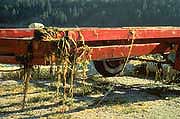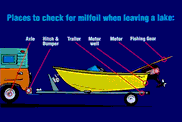What Influences Water Quality
Effects of Aquatic Plants
|
Click on the pictures to view them in more detail.
|
Aquatic plants are a valuable part of freshwater ecosystems, but they are often misunderstood. In fact, many lake residents would rather not have them in front of their homes. However, native aquatic plants provide many benefits:

- Food - Aquatic plants are an important food source for many animals. Waterfowl eat the seeds, leafy parts, and tubers of plants such as pondweeds, arrowhead, and water pepper.
- Habitat - Aquatic plants provide important living space for small animals such as aquatic insects, snails, and crustaceans, which in turn supply food for fish and waterfowl.

- Cover - Young fish and amphibians use aquatic plants as a source of cover from predatory fish and birds. This makes aquatic plants important nurseries for baby fish including our native salmon.
- Housing Supplies - Sturdy, emergent plants, like cattail and bulrush, provide nest and den building materials for many birds and mammals.

- Erosion Control - Underwater and emergent plants will protect shorelines from erosion due to wave action or currents. They can help stabilize the sediment which can increase water clarity.

- Nutrient Cycling - Aquatic plants can use nutrients that would otherwise be used by algae, thereby increasing water clarity. They have an ability to soak up pollutants from contaminated water.
- Resist Invasion - A diverse healthy native plant community will resist invasion by non-native noxious aquatic weeds such as Eurasian watermilfoil.
When Plants are a Problem
If aquatic plants are so wonderful, why are they perceived as a problem by many lake residents? Most of the time, problems arise when plants are too numerous. They can:
- Produce dense mats of vegetation that interfere with navigation and recreational activities such as boating, swimming, fishing and water-skiing.
- Impact power generation and irrigation by clogging equipment.
- Create stagnant water providing good breeding ground for mosquitoes.
- Degrade water quality by raising pH, decreasing oxygen and increasing temperature.
The causes of dense plant growth are complex. Often it is attributed to increased nutrient input from around the lake or in the watershed from sources such as failing septic systems, fertilizer runoff, or agricultural waste. These increased nutrients can cause the natural process of lake aging (eutrophication) to proceed at an accelerated rate, and increased plant and algal growth is part of this process.
Another problem can arise if a noxious, non-native weed is introduced to the waterbody. These weeds can reproduce from plant fragments, as well as seeds and tubers. The plant fragments and seeds can spread to uninfected bodies of water in a number of ways:
- Recreational users carry plant fragments from one waterbody to another on boats, skis and other equipment.
- Some people discard aquarium plants into local waterways.
- Waterplants sold to gardeners can carry non-native noxious weed fragments.
- Waterfowl can spread fragments.
- Wind, wave action and flooding can break off fragments of plants and spread them into an uninfested system.
Several foreign noxious species, such as Eurasian watermilfoil and Brazilian elodea, are very aggressive and can crowd out more desirable native vegetation.









